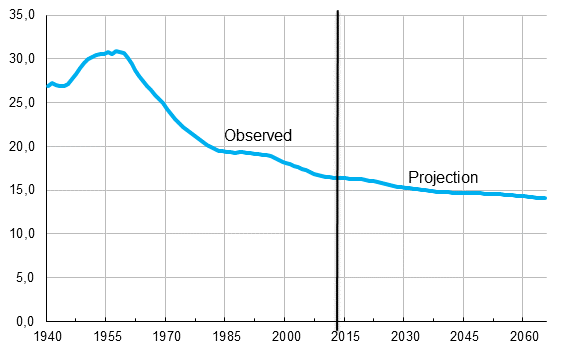Published: 30 October 2015
Share of young people in the population is in danger of diminishing further
According to Statistics Finland's latest population projection, there would be 882,000 persons aged under 15 in Finland in 2030. The number of persons aged under 15 has last been this low in 1894. At the beginning of the 1980s, one in five Finns were aged under 15. According to the projection, the share of persons aged under 15 in the population would decrease to 14 per cent by 2060. The main reason for the declining share of young people is an insufficient birth rate.
The share of persons aged under 15 in the population in 1940 to 2065, per cent

The worst is over in the decrease of the population of working age
The number of the population of working age (aged 15 to 64) was highest in 2009, when there were 3.55 million such persons in Finland. During 2010 to 2014, the number of working-age people has fallen by 69,000 persons.
According to the population projection of 2015, the number of working-age people would decrease from the current 3.48 million to 3.41 million, or by 75,000 persons, by 2030. After this, the number of working-age people would recover slightly, and by 2045 they would number 3.46 million. Then, the number of working-age people would again start declining and, according to the projection, they would number 3.40 million in 2060.
The proportion of people of working age in the population will diminish from the present 64 to 59 per cent by 2030 and to 57 per cent by 2060.
The so-called self-sufficiency forecast describes a situation where there would be no immigration and emigration at all and only the birth rate and mortality would influence the age structure. According to the self-sufficiency forecast, the number of people of working age would go down by the year 2030 by 300,000 persons and by the year 2050 by 550,000 persons.
Demographic dependency ratio weakens
The proportion of persons aged 65 or over in the population is estimated to rise from the present 19.9 to 26 per cent by 2030 and to 29 per cent by 2060. The demographic dependency ratio, that is, the number of children and pensioners per one hundred persons of working age, will go up in the near future.
At the end of 2014, the demographic dependency ratio was 57.1. According to the projection, the limit of 60 dependents would be reached in 2017 and that of 70 dependents by 2032. In 2060, the demographic dependency ratio would be 76.
Assumptions of the 2015 population projection
Statistics Finland's latest population projection assumes that the birth rate would remain constant in future. The imputed number of children that women give birth to during their lifetime, i.e. the total fertility rate is assumed to be 1.70.
The forecast also assumes that in 2015, Finland’s migration gain from abroad will be 14,000 persons and in 2016 to 2065 it will be 17,000 persons per year. Mortality is assumed to continue declining similarly to what has been detected when comparing the mortality for 1987 to 1991 and 2010 to 2014. More detailed information about the assumptions and the forecasting method can be found in the quality description.
Statistics Finland's projection is a trend calculation
Statistics Finland’s population projections are demographic trend calculations based on observations on past development in the birth rate, mortality and migration. The projections do not seek to estimate the effect of economic, socio-political regional policy and other such factors on population development.
The calculations mainly indicate the outcome from the present development under the assumption that it continues unchanged. Thus, they should not be interpreted as descriptions of the inevitable. The task of a population projection is to provide tools with which decision-makers can assess whether measures need to be taken to influence the development.
The projection has been made for the whole country up to 2065 and regionally up to 2040.
Source: Population and Justice Statistics. Statistics Finland
Inquiries: Markus Rapo 029 551 3238, vaesto.tilasto@stat.fi
Director in charge: Jari Tarkoma
Publication in pdf-format (278.7 kB)
- Tables
-
Tables in databases
Pick the data you need into tables, view the data as graphs, or download the data for your use.
Appendix tables
- Figures
- Quality descriptions
Updated 30.10.2015
Official Statistics of Finland (OSF):
Population projection [e-publication].
ISSN=1798-5153. 2015. Helsinki: Statistics Finland [referred: 18.12.2025].
Access method: http://stat.fi/til/vaenn/2015/vaenn_2015_2015-10-30_tie_001_en.html

